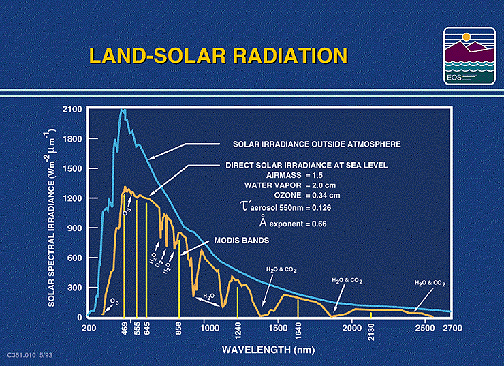

Electromagnetic Spectrum: Transmittance, Absorptance, and Reflectance
The primary source of energy that illuminates natural targets is the sun. Solar irradiation (also called insolation) arrives at Earth-at wavelengths which determined by the photospheric temperature of the sun (peaking near 5600 °C). The main wavelength interval is between 200 and 3400 nm (0.2 and 3.4 µm), with the maximum power input close to 480 nm (0.48 µm), which is in the visible green region. As solar rays arrive at the Earth, the atmosphere absorbs or backscatters a fraction of them and transmits remainder.

Upon striking the land and ocean surface (and objects, there on), and atmospheric targets, such as air, moisture, and clouds, the transmitted radiation (technically called irradiance) partitions into three modes of energy-interaction response:
(1) transmittance - some radiation penetrates into certain surface materials such as water;
(2) absorptance - some radiation is absorbed through electron or molecular reactions within the medium ; a portion of this energy is then re-emitted (as emittance), usually at longer wavelengths, and some of it remains and heats the target;
(3) reflectance - some radiation reflects and scatters away from the target at various angles, depending on the surface roughness and the angle of incidence of the rays.
When a remote sensing instrument has a line-of-sight with an object that is reflecting solar energy, then the instrument collects that reflected energy and records the observation. Most remote sensing systems are designed to collect reflected radiation.
I-10 From the above graph, calculate (approximately) the percent decrease in surface irradiance (drop in power, in Watts) of maximum solar radiation (close to 500 nanometers) from the moment it reaches the outer atmosphere until it reaches the Earth's surface; assume a vertical rather than slant path through the atmosphere. ANSWER

Collaborators: Code 935 NASA GSFC, GST, USAF Academy Webmaster: Bill Dickinson Jr.
Primary Author: Nicholas M. Short, Sr. email: nmshort@epix.net
Contributor Information
Last Updated: September '99
Site Curator: Nannette Fekete
Please direct any comments to rstweb@gst.com.